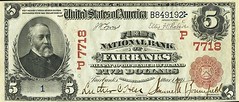
PREV ARTICLE
NEXT ARTICLE
FULL ISSUE
PREV FULL ISSUE
NATIONAL BANK NOTE CHARTER PERIOD CONFUSION
Peter Huntoon published a nice article in Bank Note Reporter October 29, 2012 about the "Charter Period" designation for U.S. National Bank Notes. Here's an excerpt from the NumisMaster site.
-Editor
A bank was said to be rechartered when it passed to a new charter period. Unfortunately, this picture is haywire and has been sewing confusion ever since.
I think they mean "sowing", but this is a great example of how what we know as numismatists changes over time, and how one book can influence generations of future collectors in continuing to perpetrate a misconception.
Like they say, don't believe everything you read!
-Editor
There are three problems. (1) Most important is the fact that the terms first, second, third and fourth charter period have utterly no basis in law or fact. There were no such things. A bank received one charter, and that was it. No national bank ever was rechartered. (2) A serious problem is that collectors associate these fictitious charter periods with specific series of notes. This comes out as: first charter notes = Original Series/Series of 1875 notes; second charter notes = Series of 1882 notes; third charter notes = Series of 1902 notes. This creates a misleading classification that simply warps reality. (3) Last is the illogical leap that always is taken, a leap off the cliff fueled by our growing confusion arising from our attempt to pound square pegs into round holes. The logic goes as follows. If first charter-period notes = Original/1875 Series notes, second charter-period notes = Series of 1882 notes, etc, then certainly first charter = Act of Feb. 25, 1863 or Act of June 3, 1864; second charter = Act of July 12, 1882; and third charter = Act of April 12, 1902. Once the charter period poison has taken hold, collectors invariably contrive the following chain of associations: First-charter period = Act of Feb. 25, 1863 or Act of June 3, 1864 = Original/1875 series notes; Second-charter period = Act of July 12, 1882 = Series of 1882 notes; Third-charter period = Act of April 12, 1902 = Series of 1902 notes. At this point, we have successfully arrived in the land of the lost and clueless.
To read the complete article, see:
Dispelling Charter Period Nonsense
(www.numismaster.com/ta/numis/Article.jsp?ad=article&ArticleId=26018)
The Numismatic Bibliomania Society is a non-profit organization promoting numismatic literature. See our web site at coinbooks.org. To submit items for publication in The E-Sylum, write to the Editor at this address: whomren@gmail.com To subscribe go to: https://my.binhost.com/lists/listinfo/esylum All Rights Reserved. NBS Home Page Contact the NBS webmaster 
|
